Padmasambhava: Difference between revisions
mNo edit summary |
|||
| Line 158: | Line 158: | ||
*[https://www.himalayanart.org/search/set.cfm?setID=100 Padmasambhava outline page at Himalayan Art Resources] | *[https://www.himalayanart.org/search/set.cfm?setID=100 Padmasambhava outline page at Himalayan Art Resources] | ||
[[Category:Guru Rinpoche]] | [[Category:Guru Rinpoche| ]] | ||
[[Category:Historical Masters]] | [[Category:Historical Masters]] | ||
[[Category:Indian Masters]] | [[Category:Indian Masters]] | ||
Latest revision as of 08:00, 14 September 2023
Padmasambhava[1] (Skt.), or Padmakara (Skt. Padmākara; Tib. པདྨཱ་ཀ་ར་, པདྨ་འབྱུང་གནས་, Pemajungné; Wyl. pad+ma 'byung gnas, in Sanskrit transliteration པདྨ་སམྦྷ་ཝ་) means ‘Lotus-born’, which refers to Guru Rinpoche's birth from a lotus in the land of Oddiyana. Guru Rinpoche, the ‘Precious Master’, is the founder of Tibetan Buddhism and the Buddha of our time. Whereas Buddha is known primarily for having taught the teachings of the sutra vehicle, Padmasambhava came into this world, and to Tibet in particular, in order to teach the tantras. While Buddha Shakyamuni exemplifies the buddha principle, the most important element in the sutrayana path, Padmasambhava personifies the guru principle, the heart of Vajrayana Buddhism, and he is therefore known as the ‘second Buddha’ (Tib. སངས་རྒྱས་གཉིས་པ་, sangyé nyipa).
Biography
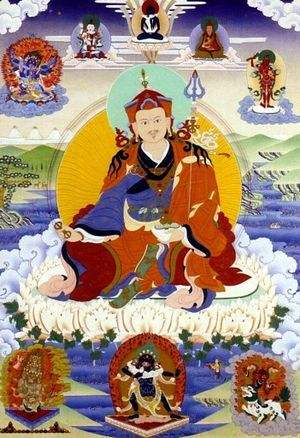
Birth
In the north-western part of the land of Oddiyana, on an island in the lake of Dhanakosha, the blessings of all the buddhas took shape in the form of a multi-coloured lotus flower. Moved by compassion at the suffering of sentient beings, the Buddha Amitabha sent out from his heart a golden vajra, marked with the syllable HRIH, which descended onto the lotus blossom. It transformed into an exquisitely beautiful eight year old child, endowed with all the major and minor marks of perfection, and holding a vajra and a lotus. At that moment all the buddhas of the ten directions, together with hundreds of thousands of dakinis from different celestial realms, invoked the blessings and the incarnation of all the buddhas for the benefit of beings and the flourishing of the secret mantra teachings. Their invocation is known as ‘The Seven Verses of the Vajra’, or ‘The Seven Line Prayer’.
It is said that his birth took place in either an Earth Monkey or a Wood Monkey year,[2] on the tenth day of the waxing moon in the monkey month. As Guru Rinpoche was born within the lotus flower upon the waters of the lake, the dakinis called out to him from their hearts, and their call spontaneously became the Vajra Guru mantra. So this mantra is his heart mantra, his life-core, his heart essence, and to recite it is to invoke his very being. It happened that at that time, the King of Oddiyana, Indrabhuti, as a result of his immense generosity to the poor and needy of his country, had finally emptied his treasury. In addition, he had no heir to succeed him as ruler, and his sight had failed him. So he had set out on a voyage on the lake of Dhanakosha to find a wishfulfilling jewel. As he returned with the jewel, he encountered the amazing child, and questioned him about his parents, his family line, his name and country, his sustenance and what he was doing there. The boy sang his reply in an enchanting voice:
- My father is the pure awareness of rigpa, Samantabhadra,
- My mother, the space of all things, Samantabhadri,
- My line, the indivisibility of awareness and space,
- My name, the glorious Lotus-born,
- My homeland, the unborn dharmadhatu,
- My sustenance, consuming dualistic thoughts,
- My destiny, to accomplish the actions of the buddhas of past, present and future.
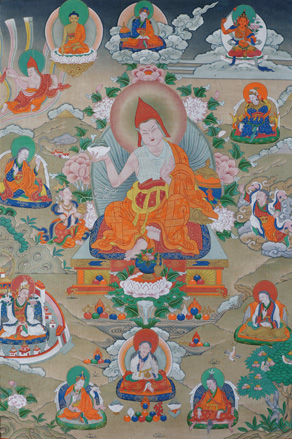
Indrabhuti took him back to the kingdom and installed him as the crown prince. At different points in his life, Guru Rinpoche is known by different names. Now he was known as Pemajungné, Padmakara or Padmasambhava, ‘The Lotus-born’, as well as Tsokyé Dorjé, ‘Lake Born Vajra’.
Marriage and Exile
Padmasambhava married the dakini Prabhavati and ruled the kingdom according to the Dharma, ushering in a time of happiness and peace. He was known then as King Tortokchen, ‘The Turbaned King’. Seeing that as a ruler he would be unable truly to serve others and bring them spiritual benefit on a vast scale, he begged for permission to abdicate, but was refused. So Padmasambhava employed a skilful device in order to escape. Perceiving that a harmful minister’s son was just on the point of dying and being reborn in the lower realms, he dropped his trident while dancing on the palace roof, and it caused the death of the child, who was liberated and reborn in a buddha realm. Padmasambhava was banished, and roamed in ‘The Chilly Grove’, Shitavana, charnel ground, and then in the other charnel grounds, ‘Joyous Grove’ and Sosadvipa. There, he received empowerments and blessings from the dakinis ‘Tamer of Mara’ and ‘Sustainer of Bliss’, and practised yogic disciplines, bringing the dakinis of the charnel grounds under his sway. The name he was known by was Shantarakshita, ‘Preserver of Peace’.
Returning to the island in Lake Dhanakosha, Padmasambhava brought its dakinis under his command. Then, in ‘The Rugged Forest’ Parushakavana charnel ground, Vajravarahi appeared to him, and blessed him. He subdued nagas of the oceans and planetary spirits of the heavens; wisdom dakas and dakinis granted him supernatural powers and siddhis, and he was known as Dorjé Drakpo Tsal, ‘Wrathful Vajra Might’.
In Zahor
At ‘the Vajra seat’ in Bodhgaya, he displayed miracles, acknowledging he was a self-manifested buddha, and then he went to the land of Zahor. Although Padmasambhava was a fully enlightened buddha, he appeared as a nirmanakaya manifestation to tame and teach beings in this age, and so for their benefit he acted as if receiving teachings, accomplishing the practice and passing through the various stages of spiritual realization, one by one. Some accounts tell how in Vajrasana, he was ordained by the Buddha’s closest disciple, Ananda. Others say he took ordination from Prabhahasti in Zahor, and was given the name Shakya Sengé, ‘Lion of the Shakyas’. He received the teachings on Yoga Tantra from him eighteen times, and experienced pure visions of the deities. Then he received empowerment from the wisdom dakini Kungamo, also known as Khandroma Lékyi Wangmo, who transformed him into a syllable HUNG, swallowed him, and passed him through her body and out through her secret lotus, granting him outer, inner and secret empowerments, and purifying the three obscurations. From the eight vidyadharas at Deché Tsekpa, he received the teachings on the eight great sadhanas of Kagyé, from Buddhaguhya the teachings on ‘The Secret Essence Tantra’, and from Shri Singha the teachings of Dzogpachenpo. Padmasambhava would master a teaching the first time he encountered it, and experienced visions of deities without needing to practise. Attaining the first vidyadhara level, the stage of ‘the vidyadhara level of maturation’ or ‘vidyadhara with karmic residue’, Guru Rinpoche was known as Loden Choksé, ‘Wise Seeker of the Sublime’.
Returning to Zahor, Padmasambhava took the royal princess Mandarava as his consort, and they then went to the Maratika cave, where for three months they practised the sadhana of longevity. The Buddha of Limitless Life, Amitayus appeared, empowered them with longevity, and blessed them as inseparable from him. They both accomplished the second vidyadhara level, ‘vidyadhara with mastery over life’.
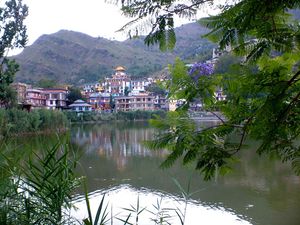
The king of Zahor and his ministers arrested Guru Rinpoche and Mandarava and burned him alive, but he transformed the pyre into a lake, and was found sitting, cool and fresh, on a lotus blossom in its centre. This lake is considered to be the Rewalsar Lake, ‘Tso Pema’, in the present-day Indian state of Himachal Pradesh. Overcome with remorse, and in homage, the king offered Padmasambhava his entire kingdom, beginning with his garments and his five royal robes. In paintings and statues, Guru Rinpoche is portrayed wearing the clothing of the king of Zahor. For example, the hat offered by the king is called The Lotus which Liberates on Sight, or The Petalled Hat of the Five Families; its inner and outer layers symbolize the unity of generation and completion phases, its three points the three kayas, its five colours the five kayas working for the benefit of beings, the sun and moon skilful means and wisdom, its blue border unlimited samaya, the vajra top unshakeable concentration and the vulture’s feather the realization of the highest view and the culmination of the practice. Guru Rinpoche taught the king and subjects of Zahor, and many attained realization.
With Mandarava, he then returned to Oddiyana, but was recognized, and burned on a sandalwood pyre. After some time, they were found seated on a lotus in a lake of sesame oil, wearing a garland of skulls, as a symbol of their liberating all beings from samsara through compassion. Padmasambhava was now known as Pema Thötreng Tsal, ‘The Powerful Lotus-born, with a Garland of Skulls’. For thirteen years Padmasambhava and Mandarava remained to teach in Oddiyana, as a result of which the king, queen and many others attained realization and the rainbow body. Then Padmasambhava was known as Padma Raja—Pema Gyalpo—, ‘The Lotus-born King’.
Manifesting himself as the monk Indrasena, it is said that Padmasambhava inspired the great king, Ashoka (3rd century BC), to have faith in the Buddhadharma. After defeating various anti-Buddhist rulers, Guru Rinpoche was poisoned, but remained unharmed, and he was thrown in the Ganges, but made the river flow upstream and danced in the air, therefore earning the name of Khyeu Khanding Tsal, ‘Mighty Youth, Soaring in the Sky like a Garuda’.
He manifested as a number of great siddhas, such as Saroruha, Saraha, Dombi Heruka, Virupa and Krishnacharya. In charnel grounds like Kuladzokpa, ‘Perfected in Body’, he taught the secret mantra to dakinis, and made outer and inner spirits into protectors of the Dharma. He was then known as Nyima Özer, ‘Rays of the Sun’.
Padmasambhava challenged and defeated five hundred upholders of wrong views in debate at Bodhgaya. He reversed their magic with the aid of a wrathful mantra given him by the lion-faced dakini Marajita. He was known as Senge Dradok, ‘The Lion’s Roar’.
At Yangleshö
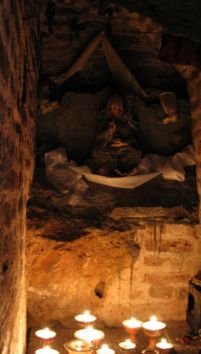
Then at Yangleshö, present day Pharping in Nepal, he practised the sadhana of Yangdak Heruka with the consort Shakyadevi, daughter of a king of Nepal. Powerful spirits caused a three year drought, with famine and disease, and Padmasambhava asked his teachers in India for a teaching to counter them. Two men returned, laden with the tantras and commentaries of Vajrakilaya, and the moment they arrived, the obstacles were pacified. Guru Rinpoche and Shakyadevi both attained the third vidyadhara level, ‘vidyadhara of the great seal, or mahamudra’. Guru Rinpoche recognized that Yangdak is like a merchant engaging in trade—the achievement can be great, but so can the obstacles, whereas Vajrakilaya is like an armed escort; he is needed to guard against obstacles and overcome them. He then composed sadhanas of Yangdak and Vajrakilaya combined, and bound the guardians of Vajrakilaya to protect the teachings.
As for the Dzogchen teachings, it is said that Padmasambhava met Garab Dorje in a pure vision, and he also received the Nyingtik teachings from Manjushrimitra. As Nyoshul Khen Rinpoche explains in his ‘History of the Natural Dzogpachenpo’ A Marvellous Garland of Rare Gems, Guru Rinpoche travelled to the Parushakavana charnel ground where Shri Singha granted him the teachings of the Three Classes of Mind, Space and Pith Instructions. After granting him the Outer, Inner and Secret cycles, Shri Singha conferred on Padmasambhava the teachings of the Innermost Unsurpassed Cycle of Pith Instructions, the Khandro Nyingtik, along with all the tantras and instructions. He stayed for twenty-five years, receiving and contemplating on this teaching. Subsequently, he went to the Sosadvipa charnel ground and practised for three years, obtaining an enlightened body that was “like the reflection of the moon in water, not subject to birth or death”. He attained ‘the rainbow body of great transference’, in which form he later went to Tibet. In this subtle light body, great masters such as Padmasambhava and Vimalamitra can remain, without dissolving into the dharmakaya, for as long as there is service to perform for sentient beings.
Guru Padmasambhava visited lands and kingdoms all over Asia, including Mongolia, China and Shangshung, where he manifested as Tavihricha to teach the hearing lineage of Dzogchen in the Bön tradition, which led many to enlightenment and the rainbow body. “In this way,” Jamgön Kongtrul writes, “Padmasambhava’s activity for leading people to the path of liberation through appearing in various places and in various forms, and speaking various languages, is indeed beyond all measure.”
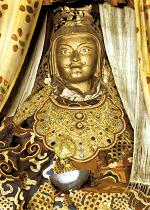
In Tibet
Now, the thirty seventh king of Tibet, Trisong Detsen, had invited the great pandita Shantarakshita, also known as Khenpo Bodhisattva, to establish Buddhism in his country. The author of the famous Ornament of the Middle Way (Skt. Madhyamakalamkara) and Compendium on Reality (Skt. Tattvasamgraha), Shantarakshita began teaching in Tibet, and laid the foundations for Samyé monastery. This provoked the local spirits, who embarked on a campaign of disasters—disease, floods, storms, hail, famine and drought—and whatever construction work was done at Samyé during the day was dismantled at night. Shantarakshita urged the king to invite Padmasambhava, and he despatched envoys under the leadership of Nanam Dorje Dudjom. With his prescience, Guru Rinpoche knew already of their mission, and had gone to meet them at Mangyul, between Nepal and Tibet. According to Kyabjé Dudjom Rinpoche, it was in the Iron Tiger year (810) that Padmasambhava came to Tibet. It is said that he was then over a thousand years old. On the way to central Tibet, he began to subjugate the local spirits and made them take oaths to protect the Dharma and its followers. He met the king at the Tamarisk Forest at Red Rock, and then went to the top of Mount Hépori and brought all the ‘gods and demons’ of Tibet under his command.
‘Glorious Samyé—the Inconceivable—the unchanging, spontaneously accomplished temple’ was then built without any hindrance, completed within five years, and consecrated, amidst miraculous and auspicious signs, by Padmasambhava and Shantarakshita.
There then began a vast undertaking, an extraordinary wave of spiritual activity in Tibet. Vimalamitra and other great scholars and masters, one hundred and eight in all, were invited; Padmasambhava, Shantarakshita and Vimalamitra gave teachings, and then worked with Tibetan translators, such as Vairotsana, Kawa Paltsek, Chokro Lüi Gyaltsen and Shyang Yeshé Dé, to translate the sutras, tantras and treatises into Tibetan; the first seven Tibetan monks were ordained into the Sarvastivadin lineage, and this was the time when the two sanghas, the monastic celibate sangha of monks and nuns and the community of lay tantric practitioners, came into being in Tibet; and Vairotsana and Namkhé Nyingpo were despatched to India to receive teachings, on Dzogchen from Shri Singha, and on Yangdak from Hungkara, respectively.
At King Trisong Detsen’s request, Padmasambhava opened the mandala of the vajrayana teachings in the caves of Chimphu above Samyé to the twenty-five disciples, headed by the King Trisong Detsen, Yeshé Tsogyal and Vairotsana; nine of the twenty-five attained siddhis through practising the sadhanas he transmitted to them. It is said that he convened them in three great gatherings, to teach the Kagyé Deshek Düpa, the Lama Gongdü, and the Kadü Chökyi Gyatso.
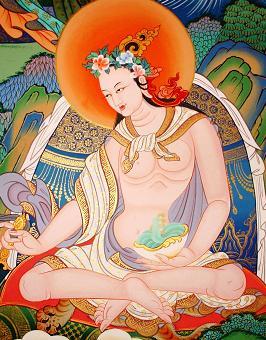
Guru Rinpoche and his closest disciple Yeshé Tsogyal travelled all over Tibet and the Himalayas, and blessed and consecrated the entire land, especially: “the twenty snow mountains of Ngari, the twenty-one sadhana places of Ü and Tsang, the twenty-five great pilgrimage places of Dokham, the three hidden lands, five ravines, three valleys and one region.”
Guru Padmasambhava made many prophecies about the future, and together with Yeshé Tsogyal concealed countless terma teachings, in order to: prevent the destruction of the teachings of the secret mantrayana; avoid corruption of the vajrayana or its alteration by intellectuals; preserve the blessing; and benefit future followers. For each of these terma treasures, he predicted the time for its revelation, the identity of the revealer, and those who would receive and hold the teachings. At thirteen different places called Tiger’s Lair, Taktsang, Guru Rinpoche manifested in “the terrifying wrathful form of crazy wisdom”, binding worldly spirits under oath to protect the terma treasures and serve the Dharma. Then he was named Dorje Drolö, ‘Wild Wrathful Vajra’.
At Shyotö Tidrö in the Drikhung Valley, the great Guru transmitted the teachings of Dzogpachenpo, the Innermost, Unsurpassed Cycle of the Category of Pith Instructions, and the Khandro Nyingtik, to a single human disciple, Yeshé Tsogyal, and a hundred thousand wisdom dakinis. Later, at Chimphu, when Trisong Detsen’s daughter, the princess Pema Sel, died at the age of eight, Padmasambhava drew a red syllable NRI on her heart, summoned her consciousness, restored her to life and gave her the transmission of the Nyingtik teachings, soon after which she passed away. Yeshé Tsogyal concealed the teachings as terma, and centuries later, Pema Sel’s incarnation, the master Pema Ledreltsal, revealed the Khandro Nyingtik cycle. His next rebirth was as the omniscient Longchen Rabjam.
Departure from Tibet
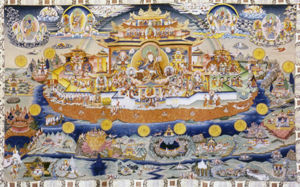
After the death of Trisong Detsen, Padmasambhava stayed on in Tibet into the reign of his successors. But he knew that the rakshasa cannibal demons, inhabiting the south-western continent of Chamara—Ngayab—were set to invade and destroy India, Nepal and Tibet, and if not subdued, they would sweep the earth and destroy all human life. So, after fifty five and a half years in Tibet, in the Wood Monkey year (864), Guru Rinpoche prepared to leave, and went, accompanied by the young king Mutik Tsepo and a large gathering of disciples, to the pass of Gungthang in Mangyul. They implored him to stay, but he refused. He gave final teachings and instructions to each of them, and then, on the tenth day of the monkey month, left for the land of Ngayab Ling in the southwest, and for his manifested pure land on Zangdokpalri, the Copper Coloured Mountain of Glory.
The many accounts of his life vie in their beauty when they come to describe his departure. The Zanglingma biography says that after giving his final instructions, “Padmasambhava mounted a beam of sunlight and in the flicker of a moment soared away into the open sky. From the direction of the south west, he turned his face to look back, and sent forth a light ray of immeasurable loving kindness that established the disciples in the state of non-return. Accompanied by a cloud-like throng of dakinis, outer and inner, and amid the sound of the music they were offering, he went to the south-western continent of Ngayab.” But different people had different perceptions of his departure. Some saw him leaving in swirling clouds of coloured light, mounted on a divine horse; others saw him riding a lion. In some accounts, the twenty-five disciples in their meditation watched him receding in the sun’s rays, first the size of a raven, then a dove, a sparrow, a bee, and finally a tiny speck that disappeared from sight. They saw him alighting in the land of the rakshasas and teaching them the Dharma.
On the peak of the Copper Coloured Mountain, Padmasambhava liberated the king of the rakshasas, Raksha Thötreng, and assumed his form. Now he dwells in Zangdokpalri as a ‘vidyadhara of spontaneous presence’, the fourth vidyadhara level: “There,” writes Kyabjé Dudjom Rinpoche, “he manifested the inconceivable Palace of Lotus Light, and there he presides as king, with one of his emanations in each of the eight continents of the rakshasas, giving teachings like the Eight Great Methods of Attainment of the Kagyé, and protecting the people of this world of Jambudvipa from fears for their life. Even to this day, he reigns as the regent of Vajradhara, the ‘vidyadhara with spontaneous accomplishment of the ultimate path’; and thus he will remain, without ever moving, until the end of the universe.”
Students
As regards Guru Rinpoche’s disciples, Jamgön Kongtrul lists “the original twenty-one disciples, the intermediate twenty-five disciples, and the later seventeen and twenty-one disciples.” Apart from his twenty-five most famous disciples, the king and subjects, Guru Rinpoche had numerous highly realized female disciples, including the five principal consorts: Yeshé Tsogyal, Mandarava, Shakyadevi, Kalasiddhi and Tashi Khyidren.
Nyoshul Khen Rinpoche said:
- Padmasambhava had twenty-five close disciples who were the first mahasiddhas of Tibet, and of these all attained the rainbow body except Trisong Detsen. At Drak Yerpa, eighty students all became mahasiddhas, attained the rainbow body and never came out of retreat; there were thirty siddhas of Yangdzong who all attained realization, fifty-five tokden, realized beings, of Sheldrak, twenty-five dakinis who attained the rainbow body, seven yoginis and the seven siddhas of Tsang.[3]
Writings
- The Garland of Views: An Instruction (Tib. མན་ངག་ལྟ་བའི་ཕྲེང་བ་, Wyl. man ngag lta ba'i phreng ba)
Major Biographies
There are many accounts of Guru Rinpoche’s life, written by great scholars or revealed by the tertöns.[4] Some of the most famous of his biographies (in chronological order of their discovery or composition) are:
- Nyangrel Nyima Özer (1136-1204), Namthar Zanglingma, ‘The Zanglingma Lifestory’, named after the Copper Temple at Samyé where it was discovered as a terma
- Orgyen Lingpa (b.1323),
- Pema Kathang or Namthar Sheldrakma, ‘The Life-Story from the Crystal Cave’
- The Five Chronicles
- Sangyé Lingpa (1340-1396), Golden Garland Chronicles or Kathang Sertreng
- Pema Lingpa (1450-1521), Torch to Dispel Darkness
- Tashi Tobgyal (1550?-1603), Ocean of Perfect Wonder
- Sokdokpa Lodrö Gyaltsen (1552-1624), Dispelling Mind's Darkness
- Taranatha (1575-1634), The Indian Version of the Life of Guru Rinpoche
- Chokgyur Dechen Lingpa (1829-1870), Wish-Fulfilling Tree
- Sera Khandro (1892-1940), Immaculate White Lotus
Further Reading
In English
- Blondeau, A.M. "Analysis of the Biographies of Padmasambhava According to Tibetan Tradition: Classification of Sources, in Michael Aris and Aung San Suu Kyi (ed.) Tibetan Studies in Honour of Hugh Richardson, Aris and Phillips, 1980.
- Chögyam Trungpa, Crazy Wisdom, The Collected Works of Chögyam Trungpa, Volume Five (Boston & London: Shambhala, 2004).
- Dalton, Jacob. 2004. “The Early Development of the Padmasambhava Legend in Tibet: A Study of IOL Tib J 644 and Pelliot tibétain 307.” Journal of the American Oriental Society 124.4: 759-772.
- Dudjom Rinpoche, The Nyingma School of Tibetan Buddhism, trans. and ed. by Gyurme Dorje and Matthew Kapstein (Boston: Wisdom Publications, 1991), vol. 1, pages 468–474.
- Ngawang Zangpo, Guru Rinpoche: His Life and Times, Ithaca: Snow Lion, 2002.
- Nyoshul Khenpo, A Marvelous Garland of Rare Gems: Biographies of Masters of Awareness in the Dzogchen Lineage, trans. Richard Barron (Junction City: Padma Publishing, 2005), pages 41–48.
- Padmasambhava & Jamgön Kongtrul, The Light of Wisdom, trans. by Erik Pema Kunsang (Boudhanath: Rangjung Yeshe Publications, 1986-1999), pages 43-47 & Appendix 5.
- Taranatha, The Life of Padmasambhava, Shang Shung Edizioni, 2005.
- Tulku Thondup, Masters of Meditation and Miracles, Shambhala, 1996.
- Yeshe Tsogyal, Life and Liberation of Padmasambhava, translated by Kenneth Douglas and Gwendolyn Bays (Emeryville: Dharma Publishing, 1978, republished 2008).
- Yeshe Tsogyal, Lotus Born—The Life Story of Padmasambhava, Rangjung Yeshe Publications, 2004.
- ‘The Life of Guru Padmasambhava’ in A Great Treasure of Blessings, The Tertön Sogyal Trust, 2004.
Teachings Given to the Rigpa Sangha
- Orgyen Tobgyal Rinpoche, Lerab Ling, 30 July-1 August 2011
- Dharma talk by Stefan Mang and Peter Woods: Pilgrimage to the Sacred Sites of Guru Padmasambhava, available on Prajna Online
Notes
- ↑ Padmasambhava is actually the specific name of one of the Eight Manifestations of Guru Rinpoche. However, this name now commonly refers to all the iconographical aspects of Guru Rinpoche.
- ↑ Discussing the date of Padmasambhava’s appearance in this world, Tsele Natsok Rangdrol says, “I find it difficult myself to identify correctly the exact years when the Buddha was born and passed away. There are many discrepancies in the various treatises, but all the histories of the Nyingma school say that Buddha Shakyamuni passed away in the year of the Fire Bird, and that Padmasambhava was born in the year of the Earth Monkey. Between these two events are twelve years, so I consider that to be the correct version.” Quoted in The Lotus-born, pp.12-13. Tsele Natsok Rangdrol Clarifying the True Meaning, from The Complete Works of rTse le rGod Tshang pa Padma Legs Grub, Gangtok, 1979, volume 3, p. 421-2. Other sources, such as Sangyé Lingpa’s revelation, the Lama Gongdü, say that Guru Rinpoche was born in the year of the Wood Monkey. Kyabjé Dudjom Rinpoche in The Nyingma School, p. 949, puts his birth in the Wood Monkey year, five years after the parinirvana of Lord Buddha, in the Iron Dragon year.
- ↑ Paris, April 12, 1986.
- ↑ According to Khenpo Palden Sherab: "Yeshe Tsogyal said that Guru Padmasambhava has nine thousand nine hundred and ninety-nine biographies. [...] These biographies are divided three ways: those relating the one hundred and eight activities of Guru Rinpoche according to his dharmakaya buddhahood, accounts told according to his sambhogakaya nature, and works chronicling his activities as a nirmanakaya buddha." (Khenchen Palden Sherab Rinpoche, 1992)
Internal Links
- Eight Manifestations of Guru Rinpoche
- Wish-Fulfilling Tree: The Life of Guru Rinpoche by Chokgyur Dechen Lingpa
- Life of Guru Rinpoche by Dudjom Rinpoche
- Twelve emanations of Guru Rinpoche
External Links
 A Concise History of Orgyen Padma’s Enlightened Deeds by Orgyen Lingpa
A Concise History of Orgyen Padma’s Enlightened Deeds by Orgyen Lingpa A Summary of the Pema Kathang by Jamyang Khyentsé Wangpo
A Summary of the Pema Kathang by Jamyang Khyentsé Wangpo Wish-Fulfilling Tree: The Life of Guru Rinpoche by Chokgyur Dechen Lingpa
Wish-Fulfilling Tree: The Life of Guru Rinpoche by Chokgyur Dechen Lingpa The Life of Guru Rinpoche by Jamgön Kongtrul
The Life of Guru Rinpoche by Jamgön Kongtrul Life of Guru Rinpoche by Dudjom Rinpoche
Life of Guru Rinpoche by Dudjom Rinpoche Prayers to Guru Rinpoche
Prayers to Guru Rinpoche TBRC profile
TBRC profile- Biography at Treasury of Lives
- Padmasambhava outline page at Himalayan Art Resources